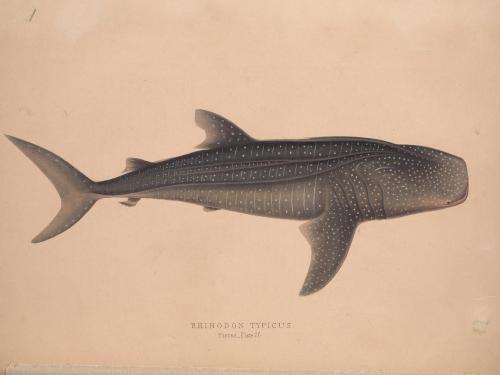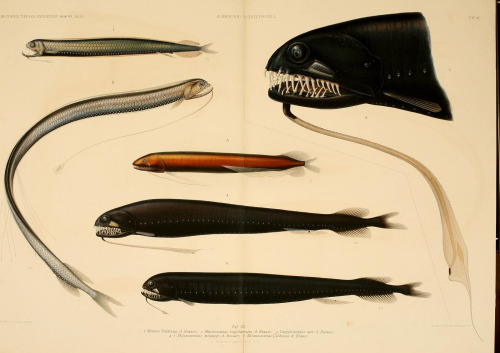Hubble Image Captures Collision Of Two Spiral Galaxies

Hubble Image Captures Collision of Two Spiral Galaxies
http://www.sci-news.com/astronomy/hubble-collision-two-spiral-galaxies-04839.html
More Posts from Hannahhaifisch and Others


Aakash Nihalani


Tetrahedrite with Siderite
Locality: Saint-Pierre-de-Mesage, Vizille, Rhone-Alpes, France

Tesla at work. (via Reddit)






‘Antique Adventures’ limited edition screenprint set






June 8th is World Oceans Day - a day to celebrate the oceans that connect and sustain all of us. Our colleagues at the Biodiversity Heritage Library have been leading up to today with a series of blog posts exploring historic publications that mark important milestones in the progress of marine bioscience research and ocean exploration.
Top image: Whale shark from Illustrations of the zoology of South Africa… v.4 (1845) Middle top : radiolarians and jellyfish from Ernst Haeckle’s Kunstformen der Natur (1904) Middle bottom: giant squid from Cassell’s Natural History v.5-6 and cuttlefish from Voyage de la corvette l'Astrolabe Mollusques and Zoophytes Atlas (1833) Bottom: deep sea fish from Valdivia Expedition…1898-1899. Bd. 15, T. 1

NGC 4725, One-Armed Spiral Galaxy



Moss Green Halite
Locality: Sieroszowice Mine, Lower Silesia, Poland
2015 Roundup
Previous years: 2014, 2013, 2012, 2011, 2010. Cool things hopefully coming to this space in 2016. In the meantime, SCIENCE!

Ghost particles.
The McGurk effect is an audiovisual illusion that works even when you know how it works. It shows that understanding speech is visual as well as auditory.

True-color composite of Pluto and its moon Charon.
Jamais vu, the evil twin brother of deja vu.
A few amusing math terms, including surreal numbers and the Cox-Zucker Machine.

The solar eclipse of March 20, 2015. Wow, has it been that long already?
How many words for snow do the Eskimos have? Answer: not as many as you think.

God’s number and the Rubik’s Cube.
Trading in futures in a feudal Japanese rice market.
Quite a few of you have been messaging me using the new messaging system on Tumblr. I can’t respond to all of you if all you say is “hi”–honestly, what did you expect? But if you have any feedback on what you’d like to see here, feel free to do so. See you in 2016, may it be another great year for science!
-
 sands-and-stars reblogged this · 8 years ago
sands-and-stars reblogged this · 8 years ago -
 flyingunderstars reblogged this · 8 years ago
flyingunderstars reblogged this · 8 years ago -
 agne-e-blog liked this · 8 years ago
agne-e-blog liked this · 8 years ago -
 farhat99ali-blog liked this · 8 years ago
farhat99ali-blog liked this · 8 years ago -
 naderqot liked this · 8 years ago
naderqot liked this · 8 years ago -
 ryoko368 reblogged this · 8 years ago
ryoko368 reblogged this · 8 years ago -
 sciencenerd4-blog liked this · 8 years ago
sciencenerd4-blog liked this · 8 years ago -
 beyondthestatic-blog1 liked this · 8 years ago
beyondthestatic-blog1 liked this · 8 years ago -
 colorfullartist liked this · 8 years ago
colorfullartist liked this · 8 years ago -
 unstable-nebulas-blog reblogged this · 8 years ago
unstable-nebulas-blog reblogged this · 8 years ago -
 unstable-nebulas-blog liked this · 8 years ago
unstable-nebulas-blog liked this · 8 years ago -
 alexzandriastormweilder liked this · 8 years ago
alexzandriastormweilder liked this · 8 years ago -
 tehcommandershepard liked this · 8 years ago
tehcommandershepard liked this · 8 years ago -
 hannahhaifisch liked this · 8 years ago
hannahhaifisch liked this · 8 years ago -
 hannahhaifisch reblogged this · 8 years ago
hannahhaifisch reblogged this · 8 years ago -
 mcm-curiosity liked this · 8 years ago
mcm-curiosity liked this · 8 years ago -
 alexandra333dowling reblogged this · 8 years ago
alexandra333dowling reblogged this · 8 years ago -
 bibliophiliosaurus reblogged this · 8 years ago
bibliophiliosaurus reblogged this · 8 years ago -
 hobs-birb liked this · 8 years ago
hobs-birb liked this · 8 years ago -
 the-telescope-times liked this · 8 years ago
the-telescope-times liked this · 8 years ago -
 the-telescope-times reblogged this · 8 years ago
the-telescope-times reblogged this · 8 years ago -
 catofglory reblogged this · 8 years ago
catofglory reblogged this · 8 years ago -
 lifeandoldstories reblogged this · 8 years ago
lifeandoldstories reblogged this · 8 years ago -
 cchris47 liked this · 8 years ago
cchris47 liked this · 8 years ago -
 scidotnews reblogged this · 8 years ago
scidotnews reblogged this · 8 years ago